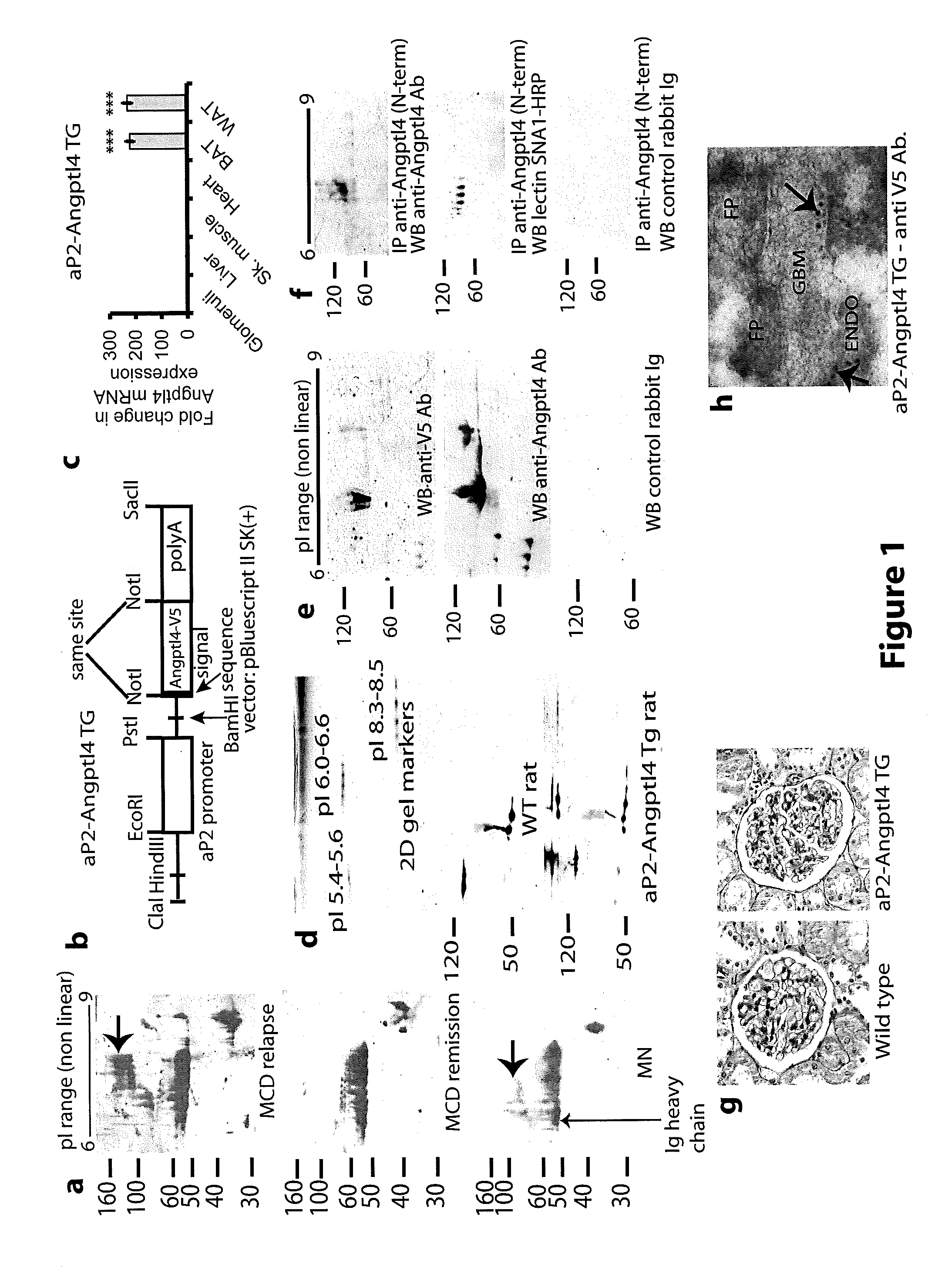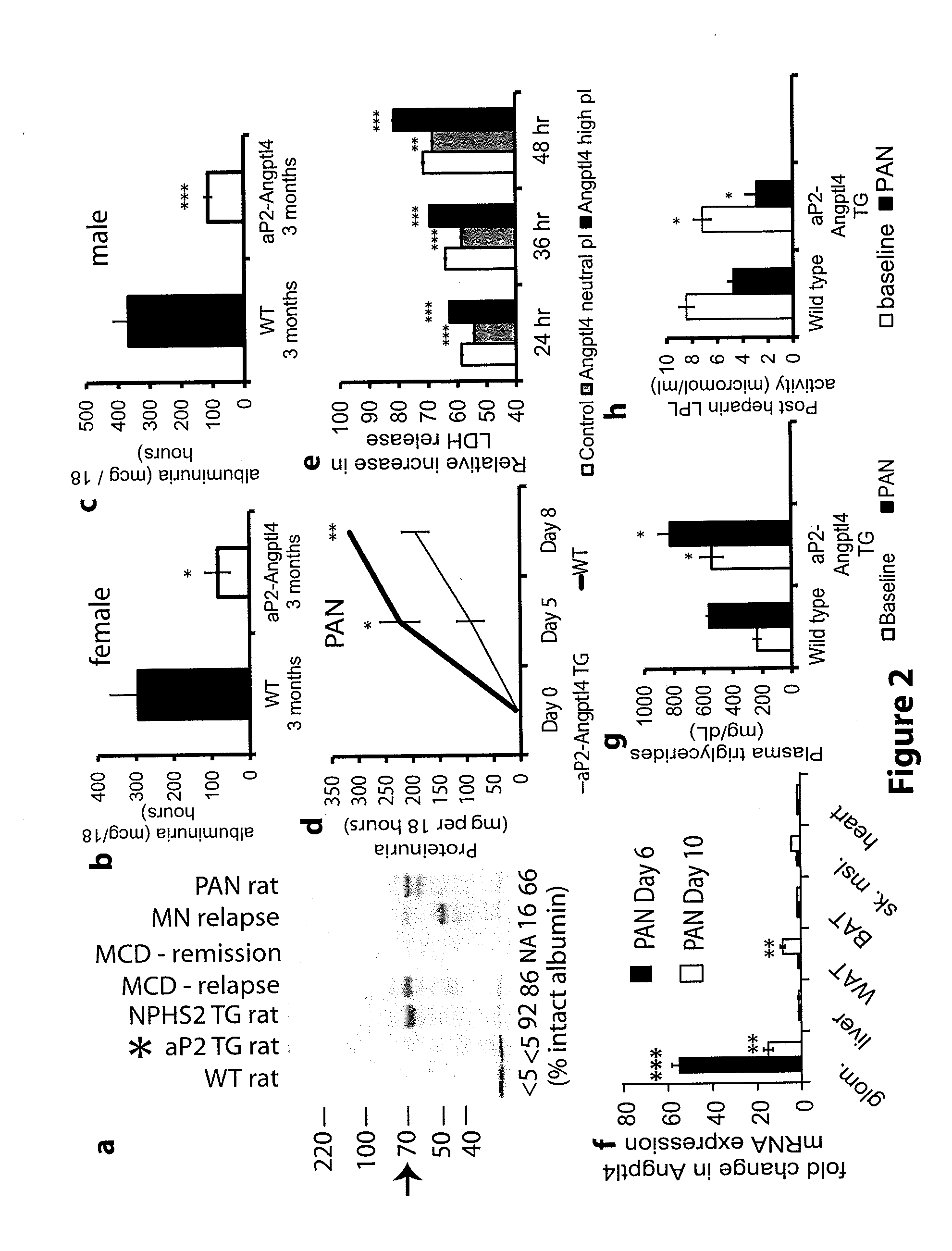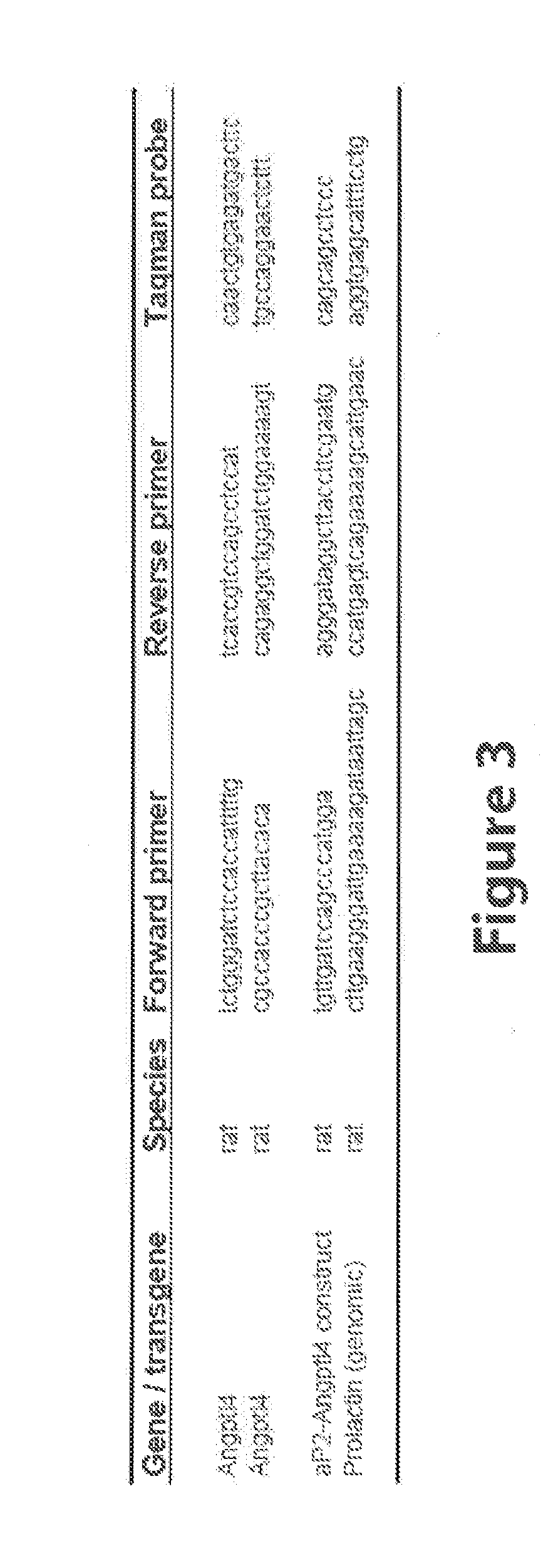Methods for Treatment of Nephrotic Syndrome and Related Conditions
a nephrotic syndrome and treatment method technology, applied in the direction of peptide sources, angiogenin, metabolism disorders, etc., can solve the problems of edema, fatigue, and people often gain weight, so as to reduce edema, reduce proteinuria, and reduce circulating levels of plasma proteins
- Summary
- Abstract
- Description
- Claims
- Application Information
AI Technical Summary
Benefits of technology
Problems solved by technology
Method used
Image
Examples
working examples
[0153]In the following results, the methods used were those methods specified in the Methods section of the present disclosure and the references cited therein. Some of the following results are described in Clement L C et. al., “Podocyte secreted Angiopoietin-like 4 mediates proteinuria in glucocorticoid-sensitive nephrotic syndrome,” Nature Medicine, January 2011 (this reference is hereby incorporated by reference for the disclosure contained therein regarding the use of Angptl4 polypeptides).
1. Patients with Nephrotic Syndrome have Increased Levels of Circulating Angptl4
[0154]Patients with Nephrotic syndrome have increased circulating levels of Angptl4 polypeptide. 200 μg human plasma from patients (n=4 patients / group) with diagnosed with MCD and MN and patients in MCD relapse were analyzed by 2D gel electrophoresis and Western blots were prepared using anti-Angptl4 antibodies (FIG. 1A). FIG. 1A shows that only patients with MCD relapse and MN had increased levels of Angptl4 (ind...
examples 1-3
Methods for Examples 1-3
Cloning of Full Length Rat Angptl4, and Generation of Antibody Against Full Length Recombinant Angptl4
[0167]The full length rat Angptl4 open reading frame of 1218 bp from our previous experiments (7), excluding the stop codon, was cloned into pcDNA3.1N5-HisB for eukaryotic expression, and into pET28a for prokaryotic expression. The E. Coli expressed purified full length protein was used to generate a polyclonal antibody in rabbits (Proteintech group, Inc. Chicago Ill. USA) that was tested by ELISA and Western blot. Antibody reactive bands were excised from GelCode blue stained gels, trypsin digested and presence of Angptl4 peptide sequences confirmed by MALDI-TOF / TOF. Part of the antiserum was affinity purified to the antigen. Unless otherwise specified, all studies described used this antibody. An additional polyclonal antibody against the N-terminal part of rat Angptl4 (amino acids 7-86 excluding signal peptide) was similarly raised in rabbits.
Induction of ...
working example 4
REFERENCES (WORKING EXAMPLE 4)
[0260]1. Nachman, P. H, Jennette, J. C. & Falk, R. Primary glomerular disease. in The Kidney, 8th edn. (ed. Brenner, B. M.) 987-1066 (Elsevier, Philadelphia, 2008).[0261]2. Marsh, J. B. & Drabkin, D. L. Experimental reconstruction of metabolic pattern of lipid nephrosis: key role of hepatic protein synthesis in hyperlipemia. Metabolism 9, 946-955 (1960).[0262]3. Vaziri N. D. Molecular mechanisms of lipid disorders in nephrotic syndrome. Kidney Int. 63, 1964-1976 (2003).[0263]4. Weinstock, P. H. et al. Severe hypertriglyceridemia, reduced high density lipoprotein, and neonatal death in lipoprotein lipase knockout mice. Mild hypertriglyceridemia with impaired very low density lipoprotein clearance in heterozygotes. J. Clin. Invest. 96, 2555-2568 (1995).[0264]5. Shearer, G. C. & Kaysen, G. A. Endothelial bound lipoprotein lipase (LpL) depletion in hypoalbuminemia results from decreased endothelial binding, not decreased secretion. Kidney Int. 70, 647-653 (...
PUM
| Property | Measurement | Unit |
|---|---|---|
| time | aaaaa | aaaaa |
| time | aaaaa | aaaaa |
| time | aaaaa | aaaaa |
Abstract
Description
Claims
Application Information
 Login to View More
Login to View More - R&D
- Intellectual Property
- Life Sciences
- Materials
- Tech Scout
- Unparalleled Data Quality
- Higher Quality Content
- 60% Fewer Hallucinations
Browse by: Latest US Patents, China's latest patents, Technical Efficacy Thesaurus, Application Domain, Technology Topic, Popular Technical Reports.
© 2025 PatSnap. All rights reserved.Legal|Privacy policy|Modern Slavery Act Transparency Statement|Sitemap|About US| Contact US: help@patsnap.com



